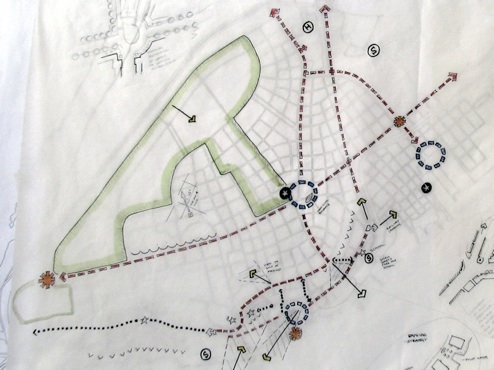Social events for the Charrette were a welcome session sponsored by CEU Norway, a cocktail reception by the British Ambassador, and a dinner hosted by the Norwegian Embassy Chargé d’Affairs
Old Havana proposals reinforced ongoing work and ideas. The power station of Tallapiedra is a potential “New Tate.” The elevated link from the National Railroad Station to the Atarés fortress could be a park. A relocated Metrobus terminal could calm the Central and Fraternity Parks. A Woonerf district on Cárdenas Street can extend the Prado in tune with the same concept and specific proposal for extending the Prado along the Capitolio till reaching the Fuente de la India monument coming from the Master Plan for XXI Century Havana, and giving continuity to this.
The Casablanca team met with local representatives of the government, the Catholic Church, the youth and other institutions. They identified a sustainable development concept to apply locally given the absence of land speculation. The model should learn and be based on the experience of join ventures that have worked in the country in the past.
Casablanca’s designs weave existing with new and call for the revitalization of the rail lines, creation of sports facilities in the existing ample green areas and development of regulations that take into account the existing landmarks. It includes new parks and squares as a natural gateway and new housing respectful of the existing topographic condition in a way that the buildings fit into the landscape without producing visual disruption, a condition analyzed and thought of during the 2007 Charrette..
The charrette’s organizers and participants concluded that redevelopment of Havana Harbour can create a great asset, Havana’s gateway and one of the great places in the world.
Charrette Organizers
Julio César Pérez
Audun Engh
Claus Zapffe
Website Editor
John Pilling
Charrette Participants
Nick Archer
José Baganha
Peter Baird
Marion Bledsoe
Milvia Céspedes
Alexis de la Cruz
Santiago Delgado
Audun Engh
Joel Estévez
Guillermo Fuentes
Alex Ginard
Héctor Gómez
Adrian Lee
Oriam Morales
Enrique Pedrero
Julio César Pérez Hernandez
John Pilling
Michael Porter
Marién Rios
Terri Sweeney
Juan Carlos Toledo
Maria Uriarte
Loren Witzel
Claus Zapffe
The iconic importance of Havana Harbour and the need for a vision for its future embodying the principles of European Urbanism are the inspirations for CEU’s charrettes in Havana.
Participants from Europe (England, Ireland, Norway, Portugal, Spain), the United States of America, and Cuba conducted The CEU’s Second Havana Harbour Charrette from the 9th to the 15th of March, 2008. It was conducted according to the schedule submitted by Julio César Pérez and agreed in advance by CEU and CEU Norway .









Second Havana Harbour Charrette
Apr 9, 2011

The Cuban and Norwegian chapters of C.E.U. - Council for European Urbanism
















































































Conducted from the 9th to the 15th of March, 2008
The Cuban and Norwegian Chapters of C.E.U. - Council for European Urbanism
Urban Design Workshop




Summary




Special Thanks
From Casablanca:
Luis Amado, Mayor
Irania Padilla, Deputy Mayor
Barbara Suarez, Head of Housing
Arturo Rague Valdez, Council of Veterans of the Revolution
Sheila Guanche Perez, Youth Club Teacher
Yanira Piusirro, Teacher
Niurka, Youth Club Director
Orestes del Castillo, Office of the Historian of Old Havana and the Heritage, Community & Environment NGO
Omar Felipe Mauri, Head, Havana Chapter of UNEAC
Jan Tore Holvik, Chargé d’Affairs, Norwegian Embassy in Havana
John Dew, British Ambassador to Cuba
Jenny White, Secretary of Science and Culture, British Council in Havana
Lolky Ferrer Professor Architect
Orlando Inclán
Niklas G. Kaste
Atarés has potential as a new residential district, combined with green and cultural issues. Improving pedestrian relationships and separating traffic by completing the main road (Primer Anillo del Puerto) can create the waterfront spine from Atarés to Regla as it was stated in the 2007 Charrette.
Regla & Refinery proposals advocated for conserving the existing, small scale and expanding similar street patterns into the refinery area as it was planned during the 2007 Charrette. An axis from the entrance to Regla Vía Blanca - one of Havanás most important roads - to the harbour that maximizes local topography and natural conditions could allow for ocean views. Also derived from this, a suggestion was made about the possibility of considering Vía Blanca in the lay out of the subway system that is another main concept of the Masterplan.

























Photo by Claus Zapffe

Photo by Claus Zapffe